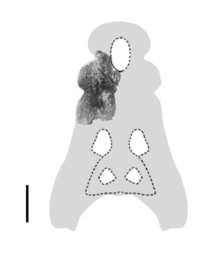| Astorgosuchus Temporal range: Late Oligocene,
| |
|---|---|

| |
| Astorgosuchus skull | |
| Scientific classification | |
| Domain: | Eukaryota |
| Kingdom: | Animalia |
| Phylum: | Chordata |
| Class: | Reptilia |
| Clade: | Archosauromorpha |
| Clade: | Archosauriformes |
| Order: | Crocodilia |
| Superfamily: | Crocodyloidea |
| Genus: | †Astorgosuchus Martin et al., 2019 |
| Type species | |
| Astorgosuchus bugtiensis (Pilgrim, 1908)
| |
| Synonyms | |
| |
Astorgosuchus is an extinct monospecific genus of crocodilian, closely related to true crocodiles, that lived in Pakistan during the late Oligocene period. This crocodile may have reached lengths of up to 7–8 m (23–26 ft) and is known to have preyed on many of the large mammals found in its environment. Bite marks of a large crocodile have been found on the bones of juvenile Paraceratherium, however if these were left by Astorgosuchus cannot be said with certainty. The genus contains a single species, Astorgosuchus bugtiensis, which was originally named as a species of Crocodylus in 1908[1] and was moved to its own genus in 2019.[2]
- ^ Pilgrim, G.E (1908) The Tertiary and Post-Tertiary freshwater deposits of Baluchistan and Sind with notices of new vertebrates. Rec Geol Surv India 37:139–167
- ^ Martin, Jeremy E.; Antoine, Pierre-Olivier; Perrier, Vincent; Welcomme, Jean-Loup; Metais, Gregoire; Marivaux, Laurent (2019). "A large crocodyloid from the Oligocene of the Bugti Hills, Pakistan" (PDF). Journal of Vertebrate Paleontology. 39 (4): e1671427. Bibcode:2019JVPal..39E1427M. doi:10.1080/02724634.2019.1671427. S2CID 209439989.